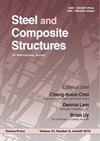New composite flooring system for the circular economy
IF 3.9
3区 工程技术
Q1 CONSTRUCTION & BUILDING TECHNOLOGY
引用次数: 4
Abstract
Circular economy is an economic system aimed at minimizing wastes and making the most of the current resources. This regenerative approach contrasts with the traditional linear economy, which has been adopted by the construction industry. Developing new construction technologies for sustainable built environment is a top priority for the construction industry throughout the world. Much of the environmental impact from the construction industry is associated with the consumption of resources and generation of waste. The construction industry in Europe consumes over 70,000 million tonnes of materials each year and generates over 250 million tonnes of waste. Composite flooring formed by connecting the concrete slabs to the supporting steel beams has been widely used for many years and is well established as one of the most efficient floor systems in multi-storey steel frame building structures. However, shear connectors are welded through the steel decking to the steel beams and cast into the concrete; this made deconstruction and reuse of these components almost impossible. A new composite flooring system which allows for the reuse of the steel beams and composite floor slabs is developed and tested to assess its potential and suitability for reuse. This paper presents the results of a series of full-scale beam tests and demonstrates the reusability of this new form of composite flooring systems. Simplified hand calculations are also provided and compared against beam tests.循环经济新型复合地板系统
循环经济是一种旨在最大限度地减少浪费和充分利用现有资源的经济体系。这种再生方法与建筑业采用的传统线性经济形成了鲜明对比。开发可持续建筑环境的新建筑技术是世界各地建筑业的首要任务。建筑业对环境的影响大多与资源消耗和废物产生有关。欧洲建筑业每年消耗超过70000万吨材料,产生超过2.5亿吨废物。通过将混凝土板连接到支撑钢梁形成的复合地板已被广泛使用多年,并且已被公认为多层钢框架建筑结构中最有效的地板系统之一。然而,抗剪连接件通过钢甲板焊接到钢梁上,并浇筑到混凝土中;这使得解构和重用这些组件几乎是不可能的。开发并测试了一种可重复使用钢梁和复合地板的新型复合地板系统,以评估其重复使用的潜力和适用性。本文介绍了一系列足尺梁试验的结果,并证明了这种新型复合地板系统的可重复使用性。还提供了简化的手工计算,并与梁试验进行了比较。
本文章由计算机程序翻译,如有差异,请以英文原文为准。
求助全文
约1分钟内获得全文
求助全文
来源期刊

Steel and Composite Structures
工程技术-材料科学:复合
CiteScore
8.50
自引率
19.60%
发文量
0
审稿时长
7.5 months
期刊介绍:
Steel & Composite Structures, An International Journal, provides and excellent publication channel which reports the up-to-date research developments in the steel structures and steel-concrete composite structures, and FRP plated structures from the international steel community. The research results reported in this journal address all the aspects of theoretical and experimental research, including Buckling/Stability, Fatigue/Fracture, Fire Performance, Connections, Frames/Bridges, Plates/Shells, Composite Structural Components, Hybrid Structures, Fabrication/Maintenance, Design Codes, Dynamics/Vibrations, Nonferrous Metal Structures, Non-metalic plates, Analytical Methods.
The Journal specially wishes to bridge the gap between the theoretical developments and practical applications for the benefits of both academic researchers and practicing engineers. In this light, contributions from the practicing engineers are especially welcome.
 求助内容:
求助内容: 应助结果提醒方式:
应助结果提醒方式:


